For the record: Sovereignty Never Ceded

First Nations Sovereignty - Resistance against invasion since the first ship arrived
Ghillar, Michael Anderson 9 April 2015
How the issue of First Nations and Peoples Sovereignty has evolved
We can say that Aboriginal people throwing spears at the first white man was an act of sovereign Peoples in defense of their lands, territories and dominions. If we are to examine the political legal action by the people and their spear throwing, it was a military exercise authorised by their law and customs which, in total, represented an Act of State on behalf of the People. They were exercising their sovereign right to defend what was theirs.
The mass destruction of our people through the foreign diseases imported to this land by the illegal British boat people was tantamount to germ warfare. The fact that the invaders were massacring hundreds and thousands of people with impunity, through private militia groups and the British Redcoats, was one of the earliest forms of genocide that equated with any of the British crusades of the earlier centuries.
The invasion of Australia by the British was in fact contrary to both the Magna Carta and the 1689 Bill of Rights, both of which still stand in law today in Britain and Australia. It should be said that the Magna Carta precluded the right of the British crown to exercise tyranny and genocide on nay people, nor was the King (or Queen) permitted to de-seize the freeman of his land and possessions.
The High Court Mabo (No. 2) decision in 1992, which concurred with the 1888 Privy Council decision St. Catherines Milling & Lumber Co. v. The Queen, was absolutely correct when the judges ruled that the proprietary rights of Aboriginal people to the land under their Law and custom survived the British Crown's sovereignty. In essence, the Australian High Court has now recognised the continuing sovereignty of Aboriginal Peoples without mentioning the word.
In the 1980s the National Aboriginal Conference (NAC) developed the hypothesis that if Aboriginal proprietary rights under our Law and customs survived British sovereignty, then the Crown's rights are only those of territorial sovereign rights, burdened by the Aboriginal Law and customs, which to this day remain the Law of the Land. It was from this that the question of continuing proprietary interest in land was pursued through the courts.

First Nations Sovereignty - Demonstrating resistance - First day of the Aboriginal Embassy outside Parliament House, 27 January 1972
The whole question of Aboriginal Nations and Peoples' proprietary rights in land have been the hidden agenda of Aboriginal Peoples since the illegal arrival of the British. While not saying it outright, our Old People in the various Aboriginal Progress Associations and other early political movements were all calling for the recognition of our civil and citizen rights. The bark petitions, the written petitions by our Old Ones who went before us were asking for the simple basic fundamental human rights that were denied to our people.
The governments, on the other hand, were very well briefed and aware of the possible ramifications that were to flow from any admission on their part that the fundamental human rights of our people were being denied, in order was to circumvent Aboriginal Peoples from coming back with the argument that now pervades the whole of the Australian legal and political debate that is currently occurring in this country, in respect of stealing our land and denying our rights in the early colonial periods of Australian history up until today.
Aboriginal Tent Embassy
Documentary by Francis Peters Little
In the 1970s Land Rights and 'Sovereignty Never Ceded' became a focal point of our Black Power movement in Sydney, Brisbane, Melbourne and later in Adelaide. The educated young Black Power people, of whom I was one, honed our arguments to focus on Land Rights. We followed the leadership of Vincent Lingiari and his Gurindji People who led by example when they walked off Wave Hill Station and took possession of Daguragu, Wattie Creek, which was part of their ancient homelands. Their actions were not just taking back their land and thereby laying the foundation for the modern day Land Rights movement, but their actions were also an Act of State that belonged to the ancient governance under their Law and custom that established them as the Gurindji Nation, with very defined territories; with an economy; a population; with a bloodline heritage birth and death registry through totemic relationships; religion and external trade relationships with other Nations. All of which are the fundamental ingredients that establish a self-governing Peoples and a Nation State, as is described by modern international law.
The street marches of the 1970s across this country heard the call 'Land Rights now' and 'Sovereignty never ceded'. These marches and the Land Rights call culminated in the establishment of the Aboriginal Embassy in Canberra. For the record it was never a 'Tent Embassy', which it is now often known as. It was an Embassy under a beach umbrella and symbolically the umbrella covered the political cry that said Land Rights now, compensation, stop killing our kids, and sovereignty was never ceded by any Aboriginal Nation or Peoples on this continent.
The emeritus professor C. D. Rowley wrote in his book The Destruction of Aboriginal Society [1971, ANU Press] that the setting up of the Aboriginal Embassy was a 'stroke of political genius', because the Embassy, just by its name suggested two sovereign entities existed on this continent and the beach umbrella sign 'Aboriginal Embassy' drew the dividing line. As the Embassy's elected ambassador, I and Billy Craigie, my Gomeroi brother, attended dinners with many ambassadors of the world where we explained our case.
In 1979 Kevin Gilbert, representing the National Aboriginal Government (NAG), took possession of Capital Hill in Canberra prior to it being destroyed, only to be replaced by the new national parliament house.
Kevin Gilbert and a group of Elders from various Nations laid siege to the top of Capital Hill. As a result of a collective agreement Kevin delivered a letter of demand to Prime Minister Fraser requesting a sovereign Treaty and Bill of Rights to be negotiated to settle this weeping sore of history and to create a proper foundation for all people in this land. Prime Minister Fraser then made an announcement that his government was prepared to negotiate a Treaty, but only with the elected body at the time, the National Aboriginal Conference (NAC).
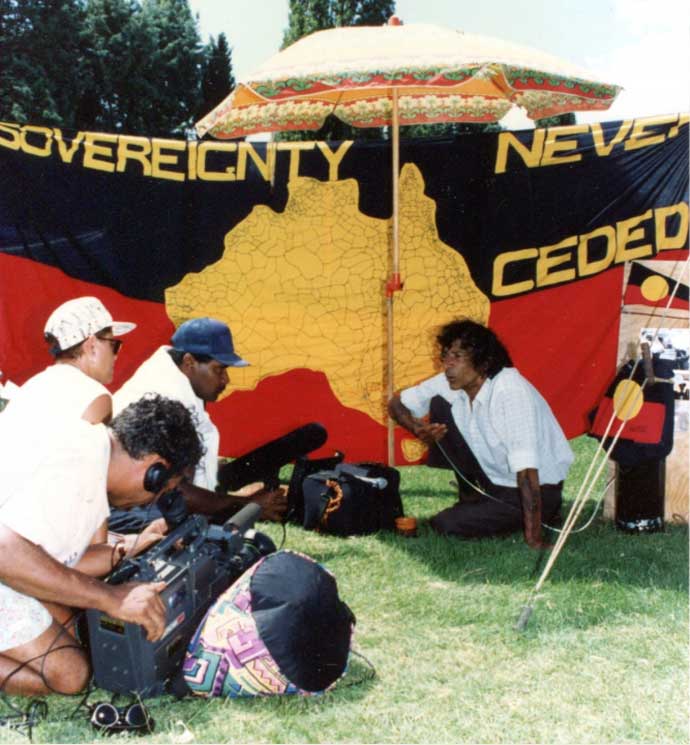
First Nations Sovereignty - The Aboriginal Embassy is re-established on 26 January 1992 and has remained ever since.
Kevin Gilbert in a TV interview at the Aboriginal Embassy in 1992
In accepting the invitation, the NAC put out two prerequisites that had to be agreed to prior to any movement along the road to negotiating a Treaty. The first was Aboriginal Nations and Peoples have retained their sovereignty and their identity to this day, despite the British occupation of our territories. The second prerequisite was our continuing proprietary and legal interest in all of the land now known as Australia and its adjacent islands.The Fraser government agreed to these terms. The NAC commenced a process of dialogue with Aboriginal communities and Peoples across Australia. This was headed up by Rev Cedric Jacobs of Perth and Lois O'Donaghue, a representative from South Australia.
In 1981 I was approached by the NAC to leave the Office of Public Prosecutions in New South Wales, criminal law division, where I was working as an instructing prosecutor in the District Court of New South Wales in Sydney. I accepted the NAC's offer and took up the position of Director of Research for the Treaty and Policy development.
In the same year the United Nations convened a World Conference of Indigenous Peoples (WCIP) which was held in Geneva, where I am proud to say, I was the first presenter globally of issues relating to the impacts of colonialism.
In 1982 the NAC set an international agenda for me, as the Director if Research, to travel to the United States, the United Nations in New York, Canada, and England to look at and study treaties between the internal nation states and the colonisers.
Interestingly enough the United States treaties do recognise in law domestic sovereignty of the tribes and nations to the point where they have self-governing powers on and within their territories. Their laws and by-laws apply to their people who live and occupy their territorial lands. They have their own legal system, police and control all economic development on their lands. More recently (2014) the US Congress and the Senate authorised their police laws on their lands to apply to non-Aboriginal people and as a consequence non-Aboriginal people can be brought before the Indian owned and run courts.

First Nations Sovereignty - Demands made to Government from Capital Hill, Canberra
Canada has now all the treaty rights entrenched within the Canadian constitution. However, those who do not have treaties continue to fight the Canadian government in the same way that we do.
My visit to the United Nations was to look at the Vienna Treaty process in order to understand the liabilities and obligations of all States to treaty without prejudice and to always negotiate in good faith.
More importantly the Vienna Convention on the Law of Treaties lays down the acceptable process for negotiating treaties, which Australia cannot in any way abrogate, when we get to that point, if we choose that pathway.
My visit to England was to study how England became the United Kingdom though the Act of Union between Scotland, Ireland, Wales and England, which has been the anchor for Britain's power. We need now to understand the four hundred year struggle waged by the people of Northern Ireland to gain their freedom and independence from the English. It took them a long time but they achieved their goal. They are still ironing out the creases of government but they have achieved their four hundred year ambition.
We also need to take heed of the more recent Scottish independence proposal, which saw the English through the British Parliament promote a plebiscite amongst the Scots as to whether they wanted to become independent and internationally recognised as the sovereign Scottish State, or remain within the Union. A similar plebiscite would be a more appropriate process and campaign for the current 'Recognise' campaign in Australia.
Having completed this study tour I returned to Canberra, where I engaged expert advisors to work with the NAC Subcommittee on Treaty and the NAC executive. The two key leading advisors were Brian Keon-Cohen and Colin Tatz. The last most notable meeting that I recall on the issue of sovereignty at this time was when the NAC national executive met with the Fraser executive government of Australia in the Cabinet room of old Parliament House. Here Prime Minister Fraser focused on sovereignty. The conclusion of these discussions, which included John Howard as the Treasurer, resulted in PM Malcolm Fraser putting a hypothetical proposition to the Chairperson of the NAC, Lyall Munro Snr. Malcolm Fraser pushed a blank piece of paper across the table to Lyall Munro saying words to the effect of: “Hypothetically, these are the signatures of the Commonwealth executive government that recognise the continuing sovereignty of Aboriginal Nations and Peoples across this continent and its islands. Now we need your signatures recognising our Australian sovereignty over the land mass and adjacent islands, thereby unifying the sovereignty of this continent into one indissoluble unity, with all the rights that we negotiated in the process.”
PM Fraser then made a further comment saying words to the effect of: “Mr Munro, now you have the paper in your hand with our signatures recognising Aboriginal and Torres Strait Islander continuing sovereignty, but then you fellows decide no, we don't want to sign it, put the paper in your pocket, get up and walk out. What happens then?”
To which Mr Munro replied: “The boot'll be on the other foot and you can call me Mr Prime Minister!”

In 1983 I wrote an information package for three key African Nation States, whom we considered the most influential in the Commonwealth Heads of Government Meeting (CHOGM). We travelled to and met with President Julius Kambarage Nyerere of Tanzania, President Mugabe of Zimbabwe, the Vice President of Nigeria. While in Nigeria we were invited by the Speaker of the parliament to address their their special foreign affairs committee. [Further detail is in our paper That word Treaty on www.sovereignunion.mobi.]
We were then invited by the World Council of Churches (WCC) in Geneva to address its international plenary session, which was attended by all political denominations, including the various religious sects. This delegation included former PM Gough Whitlam, the NAC delegate Ossie Cruse and myself and the political and diplomatic advisor.
In 1983 PM Fraser appointed a Senate Standing Committee on constitutional and legal affairs to look at negotiating a Treaty/Compact/Makarrata, with the NAC representing the Aboriginal and Torres Strait Islanders and the Commonwealth government representing its citizens of Australia.
One of the key terms of reference of the Senate Committee was Aboriginal Sovereignty v the British Crown's sovereignty. This committee travelled throughout Australia taking oral and written submission. The Senate Standing Committee on Constitutional and Legal Affairs on the feasibility of a compact or 'Makarrata' between the Commonwealth and Aboriginal people filed its report entitled Two Hundred Years later, which was tabled before the Parliament.
The sad part of that report was how they reported the late Rob Riley's position on behalf of the NAC. He had just won the Chair of the NAC over Lyall Munro Snr, in 1984. He addressed the final hearing of the Senate Standing Committee saying that the NAC would no longer pursue the sovereignty issue. This statement was aligned to the Federation of Aboriginal Land Council's position that was submitted by Patrick Dodson at the Alice Springs hearings, where Patrick Dodson told the Committee that sovereignty was not the issue and that Land Rights was the only issue that was of concern.
When Bob Hawke was elected Prime Minister, he and the late Mr Clyde Holding, deceived Aboriginal people by saying they would negotiate a Treaty as well, and then shut down the treaty process, including defunding the democratically elected NAC.
The NAC was disbanded in 1984 and silence fell on the home front, until Kevin Gilbert personally resurrected the issue of the Sovereignty debate, when he began to campaign on this point and personally began the Treaty 88 campaign, putting out as much simplified information as he could, including a definitive argument on sovereignty in his book Aboriginal Sovereignty, Justice, the Law and Land. His call resonated with grassroots Aboriginal people all over the country, so much so that Yothu Yindi won many accolades, including international awards, for their song Treaty.
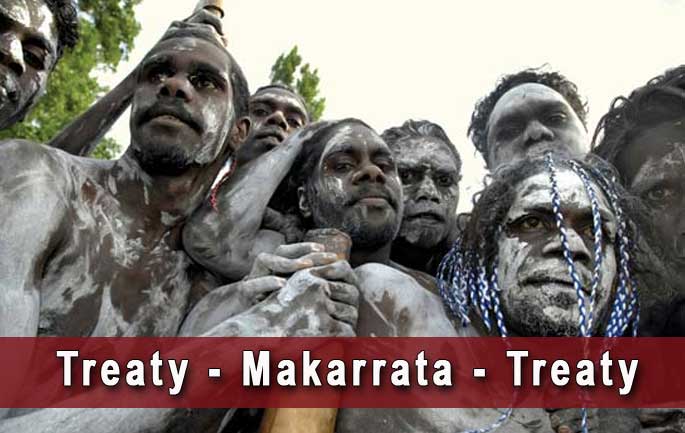
In 1999 I convened a gathering of minds from across the continent on the top of Mt Kaputar, near Narrabri, an ancient ceremony ground and trading ground for my Dad's People, the Gomeroi. Here we founded the Sovereign Union of Aboriginal Nations and Peoples in Australia (SUANPA), a body that would co-ordinate campaigns throughout the world for the sovereign recognition and rights of Aboriginal Nations and Peoples across this country.
Our first campaign endeavours were to get to the United Nations Working Group on Indigenous Peoples and the Committee on the Elimination of Racial Discrimination (CERD) to campaign against the racist abuse of executive powers by the Howard government, in respect of amending the Native Title Act, in favour of freeing up the country for the trans-national corporate mining sector and other developers. Moreover, these amendments also paved the way for Australian governments to unilaterally establish American military complexes on or adjacent to Aboriginal owned lands through out the north of Australia. Included in these activities were our submissions to the Committee on Economic, Social and Cultural Rights, the Human Rights Committee and the UN subcommittee on the Promotion and Protection of Human Rights. We also made presentations to the Third Committee for matters to be considered by the General Assembly and met with the Russian Chair of the Committee for Decolonisation in New York.
The United Nations invited SUANPA (Sovereign Union) to become a UN registered Non-Government Organisation (NGO), which gave us speaking rights at the World Conference Against Racism (WCAR) in Africa in 2002.
Up until 2010 I had been attending the Working Group on the Rights of Indigenous Peoples at the UN, during those formative years to develop the Declaration on the Rights of Indigenous Peoples, which concluded in 2007.
In 2010 it became clear that we needed to educate our people on the issue of sovereignty, self-determination and independence and I convened the New way Summit gatherings to talk up these three key elements, which are now the central theme of our political movements across this continent. These New Way summit forums were held in Canberra, Sydney, and Melbourne over the next two years, from which the Sovereignty Movement for independence and self-determination gained its momentum.
During this time I did learn that there were various groups setting out to design their own pathways and it was my opinion, and it remains my opinion, that everyone is heading towards the same goal, waterfall or cliff. Each having their own political ideologies and legal pathways. The appropriate metaphor is – we are all in the same river, heading in the same direction, but we are paddling our own canoes. For the life of me I do not understand how this has become a race, or a dog fight over political and legal ideologies. Ego is a bitch. It is my hope that one day someone can step into my shoes and take it over, so that I can go fishing and enjoy the rest of my life, knowing that other younger people can now see the big picture and are prepared to commit themselves to the fight that lays ahead of us. The toll that such a protracted campaign takes does have its affects after many years of slogging through the mud and gutters, where a lot of sweat and blood has been lost.
With a little bit more tutoring I believe each Nation can run their own course and design their own pathways to locating their own solutions, but they need to be made aware of all their rights, not just bits and pieces of them. As a researcher and a person university trained in law and legal practice, political science and history I do know how to write papers and regard myself as being very skilled in conducting legal and political, economic and social analyses, thereby enabling me to assess the ramifications and consequences of our strategies.
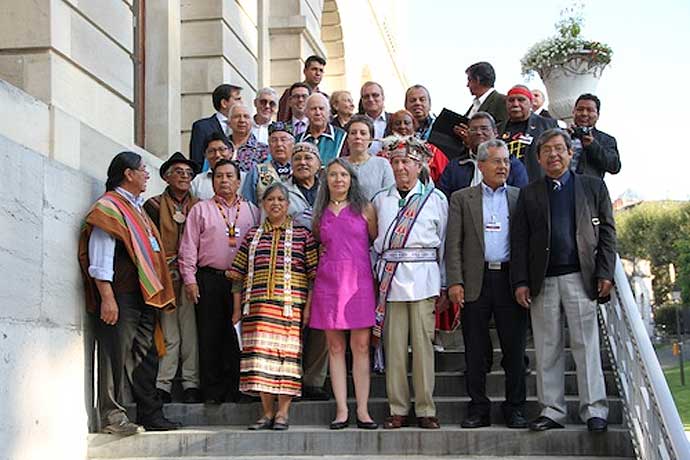
Historical Symposium on Indigenous Peoples at the United Nations Geneva, September 2013
Ghillar Michael Anderson, Sovereign Union Convenor (back row - far right with red bandana)

Historical Symposium on Indigenous Peoples at the United Nations, Geneva in 1981
Ghillar Michael Anderson (back row 2nd from right)
Our endeavour is to educate our people of their rights and suggest pathways to locate solutions. The rest is up to the people themselves, for I learnt a big lesson in 1972, when I came home to continue my ceremonial education from the most senior Elders of my Mother's and Father's Peoples, the Euahlayi and Gomeroi. While sitting at a fire on the Bokara River at one of our ceremonial campsites, one of the old Clever fellows said to me with words to the effect of: “Hey, Ghillar, I heard you on the radio the other night saying all Aborigines want Land Rights.” My reply was: “Yeh, that's right.” and his response was with words to the effect of: “How do you know? Did you talk to all Aborigines? Because if you didn't then you can't say that on that radio, all you can say is 'this is what my mob want.'”
The lesson learnt is that I should propose the questions and if people choose to pursue them, then I will assist them to gain an understanding of the issue and assist them in achieving their desired goal.
I admit that, as is a normal process, when I am stumped on a political or legal point I seek advice from known and established experts in their field in the matter, both at the domestic and international level- and over the years of campaigning I have met many experts in various fields who remain to this day as supporters.
I do understand who our enemy is and I do understand how they work. Our enemy is the government which denies us our rights and fights to keep us enslaved to, and under, their colonial system. The dole cheque and pensions are the chains around our peoples' necks that keep us enslaved. Any political movement that may threaten the flow of welfare payments is rejected by my our own people. This is the bond that the government has created and cleverly manipulates this power to threaten people and thereby keep them enslaved to their system. So people like me and others, who dare to challenge the status quo are promoted by the opposition as trouble makers to be avoided. As the saying goes – he/she who controls the purse strings is the power-broker.
This is not just a fight for sovereignty. It is a fight to be free in our own land. Those who are fighting the parallel fight must realise that our political minds will from time to time be in synch, as we are fighting a common cause on common grounds.
My years of experience on this and many other issues has created a wealth of knowledge. I have met with and talk to many other liberationists around the world. I have learnt many of the pitfalls of past movements and understand their failures. Consequently, I plan and strategize in such a way that we avoid the same pitfalls. When I feel stumped I consult with various other colleagues, who understand liberation movements, in order to avoid painting ourselves into a corner. There are many professionals and experts who support what I do and do throw their two bobs worth in from time to time.
This is a war that cannot be won by one person, but we need to set the goal and paint the big picture, because at the end of this struggle we must all be sovereign free people with the political and legal right to be self-determining in every sense of the word. More importantly along this road to liberation, we must remain true to our ancient cultures and beliefs and we all have an obligation to this end, as we hold the secret knowledge of the oldest culture on earth.
Epilogue: About the flags:
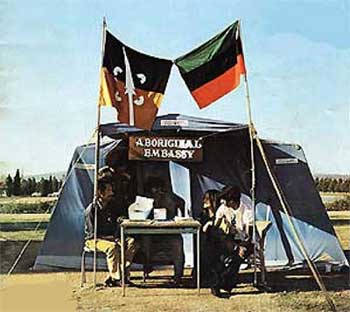
Aboriginal Embassy 1972, 'old' Parliament House
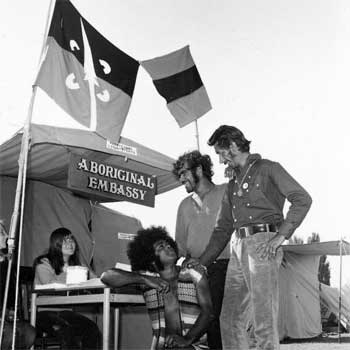
Aboriginal Embassy 1972, 'old' Parliament House
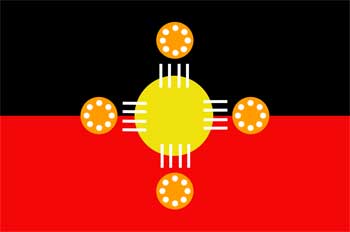
Many people make enquiries as to our flags and their origins. The first flag to fly in our political struggle, to my knowledge, was the Aboriginal Embassy flag that flew over the tent that was donated by the Quakers, Canberra branch. This flag was yellow ochre,black and white. A ceremonial barbed spearhead is depicted diagonally and the four white arcs and Black dots represent people sitting around trouble, which was represented by the barbed spearhead.
Then I hand sewed a red, green and black flag to fly with it. This flag was influenced by the Marcus Garvey political ideology as a symbol of unification of the black people of the world, who were enslaved by the colonialists.
In June of 1972 the red, yellow and black flag arrived at our march to defend the Embassy in 1972. It had been flown in earlier marches in South Australian rallies. It was quickly accepted by our people and it now represents Aboriginal People and Land Rights and served to united our people under a single banner.
I might add that the Sovereign Union movement now encourages Aboriginal Nations to design their own flag to depict their land and their culture as part of independence.
[The official flag of the Sovereign Union has a twofold meaning, but principally it represents 'The Law of the Land and the Peoples' - details here.]
Despite our troubles with the British invader society they do have a legal understanding of the symbolism of flags and banners, which represent the people, the land and who they are.
This is clearly evident that there is a great deal of power in this because when we invaded the forecourt of parliament house on 27 January 2015 the most senior police officer who was holding me and trying to block my progress was not worried about us walking to the forecourt and having a sit-in, but was simply shouting at me: “You can't bring your flags!” but this fell on deaf ears!

